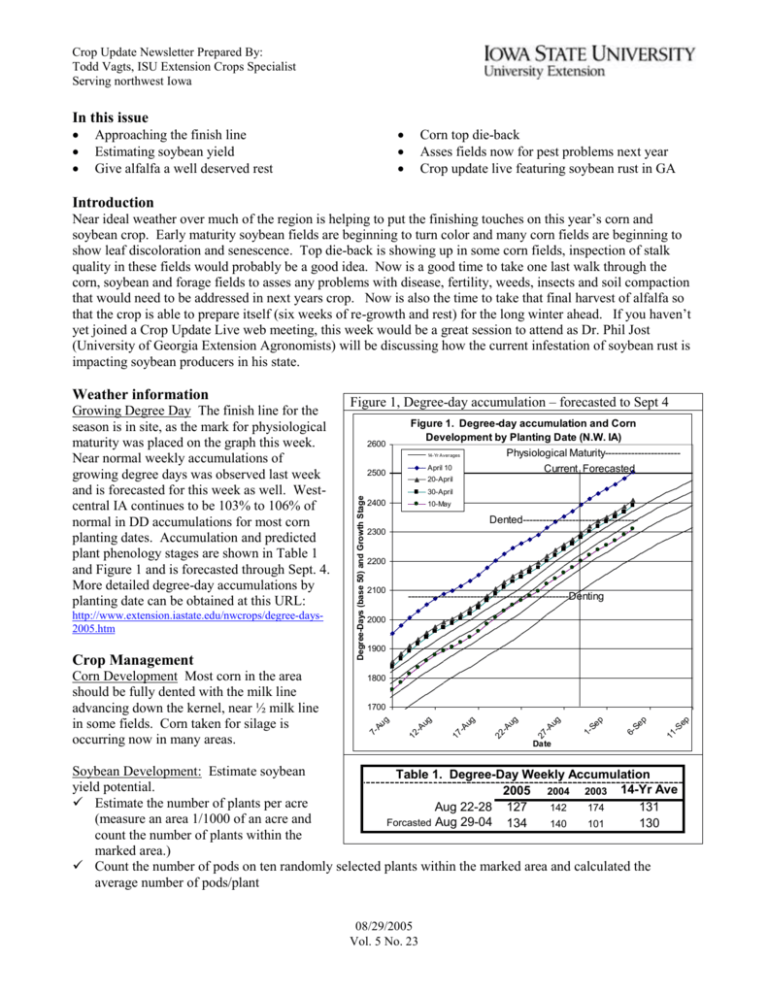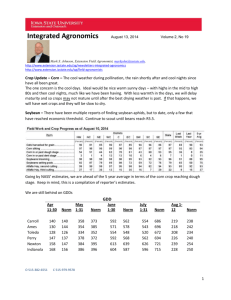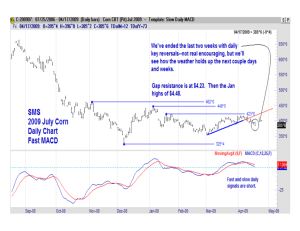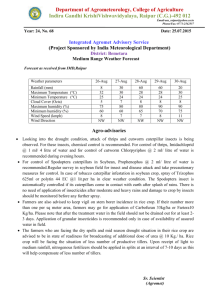Introduction - Iowa State University Extension and Outreach
advertisement

Crop Update Newsletter Prepared By: Todd Vagts, ISU Extension Crops Specialist Serving northwest Iowa In this issue Approaching the finish line Estimating soybean yield Give alfalfa a well deserved rest Corn top die-back Asses fields now for pest problems next year Crop update live featuring soybean rust in GA Introduction Near ideal weather over much of the region is helping to put the finishing touches on this year’s corn and soybean crop. Early maturity soybean fields are beginning to turn color and many corn fields are beginning to show leaf discoloration and senescence. Top die-back is showing up in some corn fields, inspection of stalk quality in these fields would probably be a good idea. Now is a good time to take one last walk through the corn, soybean and forage fields to asses any problems with disease, fertility, weeds, insects and soil compaction that would need to be addressed in next years crop. Now is also the time to take that final harvest of alfalfa so that the crop is able to prepare itself (six weeks of re-growth and rest) for the long winter ahead. If you haven’t yet joined a Crop Update Live web meeting, this week would be a great session to attend as Dr. Phil Jost (University of Georgia Extension Agronomists) will be discussing how the current infestation of soybean rust is impacting soybean producers in his state. 20-April 30-April 2400 10-May Dented----------------------------------2300 2200 2100 -------------------------------------------------Denting 2000 1900 1800 11 -S ep 6Se p 1Se p 27 -A ug 1700 22 -A ug Corn Development Most corn in the area should be fully dented with the milk line advancing down the kernel, near ½ milk line in some fields. Corn taken for silage is occurring now in many areas. 2500 17 -A ug Crop Management 2600 Figure 1. Degree-day accumulation and Corn Development by Planting Date (N.W. IA) Physiological Maturity----------------------14-Yr Averages April 10 Current Forecasted 12 -A ug http://www.extension.iastate.edu/nwcrops/degree-days2005.htm Figure 1, Degree-day accumulation – forecasted to Sept 4 Degree-Days (base 50) and Growth Stage Growing Degree Day The finish line for the season is in site, as the mark for physiological maturity was placed on the graph this week. Near normal weekly accumulations of growing degree days was observed last week and is forecasted for this week as well. Westcentral IA continues to be 103% to 106% of normal in DD accumulations for most corn planting dates. Accumulation and predicted plant phenology stages are shown in Table 1 and Figure 1 and is forecasted through Sept. 4. More detailed degree-day accumulations by planting date can be obtained at this URL: 7Au g Weather information Date Soybean Development: Estimate soybean Table 1. Degree-Day Weekly Accumulation yield potential. 2005 2004 2003 14-Yr Ave Estimate the number of plants per acre Aug 22-28 127 142 174 131 (measure an area 1/1000 of an acre and Forcasted Aug 29-04 134 140 101 130 count the number of plants within the marked area.) Count the number of pods on ten randomly selected plants within the marked area and calculated the average number of pods/plant 08/29/2005 Vol. 5 No. 23 Crop Update Newsletter Prepared By: Todd Vagts, ISU Extension Crops Specialist Serving northwest Iowa Calculate pods per acre by multiplying plants/acre by pods/plant Calculate seeds per acre by multiplying pods per acre by an estimate of 2.5 seeds/pod Calculate pounds per acre by dividing seeds/acre by an estimate of 2900 seeds/pound Estimate yield by dividing pounds/acre by 60 lbs. per bushel. The formula is: [(plants/acre) x (pods/plant) x (2.5 seeds/pod)] / (2900*60) = Estimated Yield bu/acre This formula uses several estimations and therefore may be variable depending on the final number of seeds per pod and seed weight. (Source: Corn and Soybean Field Guide, 1997; Purdue University Coop Extension Service) Forage and Pasture Management Give alfalfa a rest before winter. The timing of the last harvest of alfalfa affects its winter survival and next spring's vigor. Alfalfa needs about six weeks of uninterrupted growth in the fall to become fully winterized. Dr. Barnhart (ISU’s Extension Forage Specialist) recommends that for the best survival of the stand, attempt to take the last summer cut by late August or very early September, and let regrowth stand in the field. http://www.ipm.iastate.edu/ipm/icm/1999/9-13-1999/alfalfaman.html Pest Management Top die-back I’ve noticed in many corn fields west of Carroll where the corn appears to be prematurely dieing or is maturing from the top down rather than the normal bottom to top. I believe this may be due to an uncommon situation where anthracnose stalk rot is attacking the plant causing what is commonly called top dieback. For a very good summary of this disease, refer to this 2002 ICM newsletter. http://www.ipm.iastate.edu/ipm/icm/2002/9-23-2002/anthracnose.html Scout and evaluate corn and soybean field health now while you have time. Many disease, insect and weed pest problems can be found in area corn and soybean fields now. Obtaining a positive ID on a disease, weed or insect will be very important when making crop rotation, hybrid and variety selection decisions for next year. Be sure to utilize the ISU plant disease clinic (http://www.extension.iastate.edu/Pages/plantpath/pdcintro.html), and/or the ISU weed, insect and soil fertility specialists when confronted with an unknown problem. When scouting fields, be sure to dig plants and examine the root system, the lower stalk area, split stems and collect soil and plant samples for further testing if the problem is not easily identified. Soybean Aphid Aphid populations explode in numbers in many west-central IA soybean fields last week, most likely in response to mild air temperatures. Most soybean fields are at or past the R6 growth stage where our current research suggest we would not observe a response in yield with an insecticide treatment. In the past, aphid populations tend to decrease or entirely disappear near the end of August or into early September. ICM Newsletter: Refer to this week’s ISU Extension Integrated Crop Management newsletter for many good articles on soil and pest management: http://www.ipm.iastate.edu/ipm/icm/ Crop Update Live special feature on soybean rust in the southeastern U.S. Be sure not to miss this week’s “Crop Update Live” web meeting (Friday morning at 7:30 am) as Dr. Phil Jost (University of Georgia Extension cotton and soybean specialist) will discuss the current situation of soybean rust in the State of Georgia. This will be an excellent opportunity for you to submit questions to Dr. Jost on how Georgia soybean producers are responding to soybean rust in their operations. The state of Georgia is where soybean rust appears to be most active at this time. To join the web meeting, click on this link http://breeze.extension.iastate.edu/r20526204/ Friday morning at 7:30 am. To view a recording of this or past meetings, browse to the Crop Update Live webpage: http://www.extension.iastate.edu/nwcrops/cropupdate_live_2005/. The link to the “live” meeting will be active on the web page until it is replaced with the link to the recording following the meeting. 08/29/2005 Vol. 5 No. 23 Crop Update Newsletter Prepared By: Todd Vagts, ISU Extension Crops Specialist Serving northwest Iowa For further information pertaining to this newsletter; please contact me or any of the county extension offices. This newsletter can also be accessed on-line at http://extension.iastate.edu/carroll/crops/newsletter_2004.htm. If you would like this letter to be emailed directly to you, please send an email with the desired email address to vagts@iastate.edu. This newsletter is available via fax (in selected counties) or e-mail and can always be found on the web at http://www.extension.iastate.edu/nwcrops/newsletter_2005.htm If you would like to receive this newsletter in a format (different than what you currently receive), please let me know by phone (712-792-2364) or email (vagts@iastatte.edu). ****************************************************************************** Todd Vagts Iowa State University Extension Field Specialist, Crops 1240 D. Heires Avenue Office: 712-792-2364 Carroll, IA 51401 Cell: 712-790-0351 Email: vagts@iastate.edu Fax: 712-792-2366 Web Page: http://extension.iastate.edu/nwcrops/ Provided to you by: IOWA STATE UNIVERSITY OF SCIENCE AND TECHNOLOGY COOPERATIVE EXTENSION Information given in this publication is for educational purposes only. Reference to commercial products is made with the understanding that no discrimination is intended and no endorsement by Iowa State University with any specific product(s) used in this is implied Iowa State University and U.S. Department of Agriculture cooperating Extension programs are available to all without regard to race, color, national origin, religion, sex, age or disability. 08/29/2005 Vol. 5 No. 23







